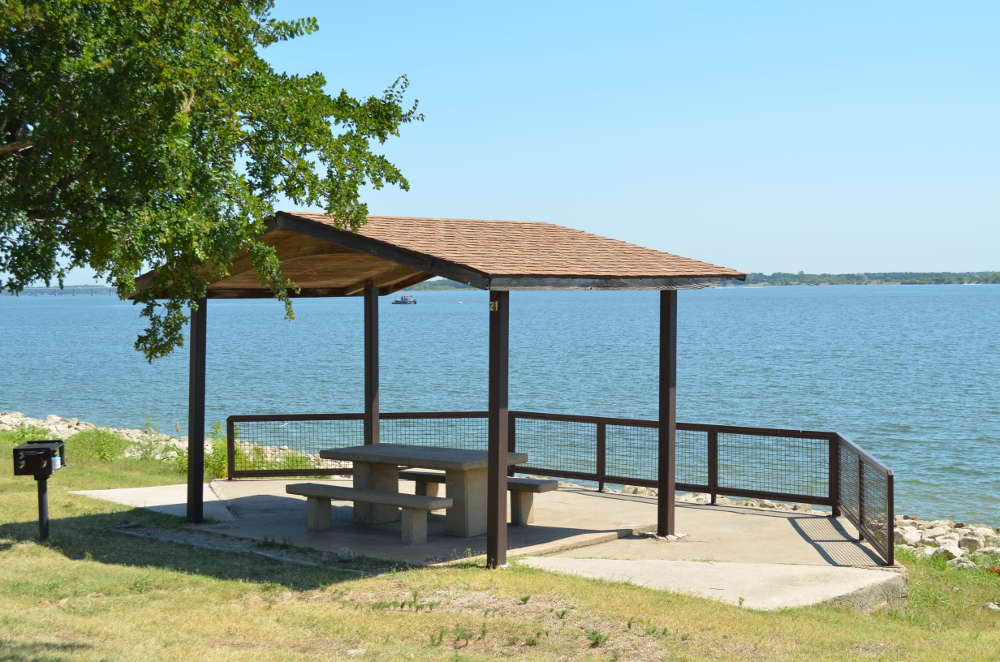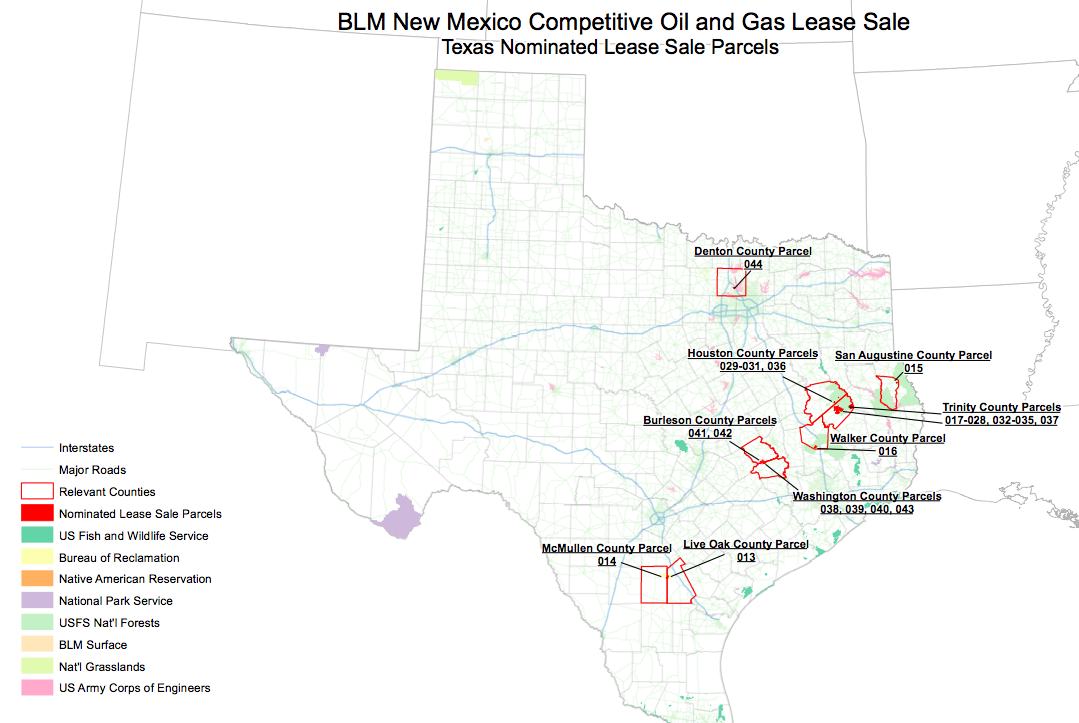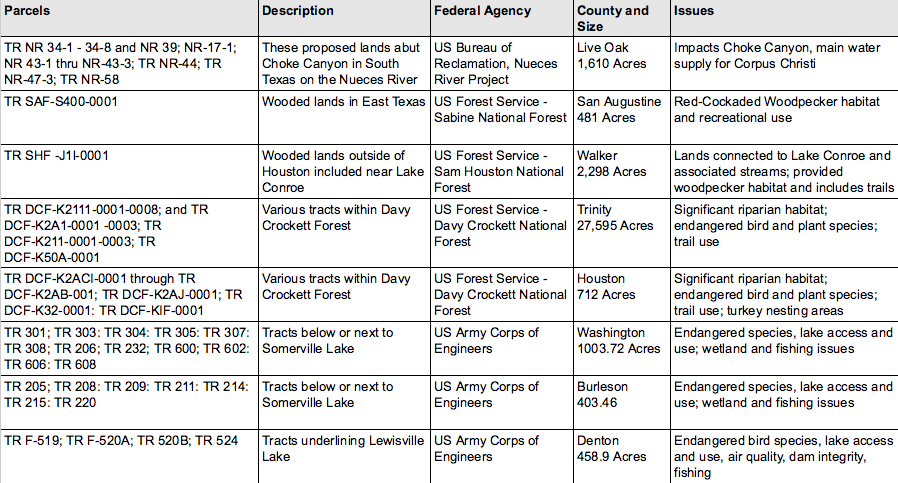
By Cyrus Reed
Does oil and gas extraction on public lands matter in Texas? You bet it does, and you need to get involved.
From California to Ohio to Louisiana, citizens are fed up with our federal government leasing off our public lands for oil and gas extraction. Grassroots organizations have been organizing, holding actions, and calling on the Bureau of Land Management (BLM) to stop selling off our public lands for fossil fuel extraction. However, for those us living in Texas, where virtually all land is private, does it really matter?
I mean, Texas is the undisputed king of oil and gas production, easily beating our nearest competitors of North Dakota and California, but we don't worry much about leasing on public lands.
We should.
First the facts. There ain’t much surface land managed by the BLM in Texas. In fact, there appears to be only one tract of land – about 12,000 acres near Amarillo that is used to mine… helium (Click here for fun facts about the Cross Bar Ranch).
However, the BLM does administer mineral leasing underneath lands managed by other federal agencies, such as the U.S. Forest Service and the U.S. Army Corps of Engineers. In fact, for many years in Texas, BLM has been leasing land owned by other federal agencies for oil and gas development.
While the BLM in Texas does administer a very small amount of the 700 million acres of sub-surface mineral estate nationwide (about 4.5 million acres), much of it is part of the U.S. Forest Service. That amount, 4.5 million acres, is small relative to the 237 million acres of federal mineral rights in Alaska, and the 47.5 million acres in California, but 4.5 million acres is a lot of land that could be leased to the highest bidder.
Indeed, some of it has already been leased, while other leases are being proposed. For example, by the end of Fiscal Year 2014, 727 separate leases were helping oil and gas in Texas extract on roughly 430,000 acres of land, while nationwide, there were some 46,183 leases, most of them in the western states, covering some 34.5 million acres of public lands.
How Is It Supposed to Work?
It’s a somewhat convoluted process, but about every three months the BLM selects and auctions off public lands for oil and gas leasing (and, until recently, intermittently for coal leasing) where there has been an interest. There is a process whereby the public – as well as registered oil and gas companies and their agents – can get involved.
The problem is most people don't know about it.
First, the BLM will put out a notice on the potential for oil and gas leasing on particular tracts of surface and mineral estates. After initial feedback (if any), then the BLM conducts an initial Environmental Assessment (EA) while consulting with certain federal agencies and provides a space for written comments by any interested parties. They can then modify the initial list of proposed places for leasing, or even decide not to move forward on leasing. If the BLM decides to go forward with the sale, then it will issue its intent to lease at a particular time and place, and then the public has another 30 days to “protest” any particular lease or leases proposed in the sale.
What’s on the Chopping Block?
Currently, the BLM of New Mexico (there is no similar BLM state office in Texas) is planning to hold a competitive oil and gas lease sale on April 20 at their state office in Santa Fe, at which up to 44 parcels, including 32 in Texas covering some 34,446.81 acres, could be bid off to the highest bidder.
You read that right. Texas public land is going to be leased in New Mexico. Where are these nominated parcels you ask? All over.

From South Texas brush country to the piney woods of East Texas to the lakes of North Central Texas, the BLM – along with other federal agencies – has decided that the minimal leasing fees plus the 12.5 percent royalty on any production is worth the risk in proposing to lease out these lands. This is just half the royalty the State of Texas charges on state leases.
Some of the key lands include significant tracts in Trinity and Houston Counties within the Davey Crocket National Forest, lands in or abutting Somerville Lake in Washington and Burleson Counties, within Lake Lewisville in Denton County, along the Nueces River in McMullen and Live Oak Counties, and in the Sam Houston National Forests, in Walker and San Augustine Counties.
Proposed Parcels in Texas Slated for Oil and Gas Lease Auctioning on April 20

While all of the proposed leases would include stipulations designed to protect lakes, wetlands, and endangered species, among other issues, the fact is that most Texans living near or using Lake Lewisville – as well as people who drink water in Dallas – or walking in the forests of Sam Houston or Davy Crockett, have no idea that a fire sale in Santa Fe is occurring in April to potentially drill for oil and gas.
To know about it ahead of time, you would have to be in the habit of regularly checking the BLM website.
Fortunately, some organizations do keep an eye on this sort of thing.
During the 30-day comment period on the Environmental Assessment the Center for Biological Diversity, the Sierra Club, and others sent a letter to the BLM (and here's the map that goes along with the letter). The letter criticized the lack of specific information in the Environmental Assessment, and called for a much more rigorous assessment, especially related to the failure of the EA to properly assess some of the lands in the Sam Houston Forest slated for development.
On January 18, the BLM essentially ignored the letter and issued their plan to go ahead with all of the proposed tracts, with the exception of one tract in Oklahoma that had been improperly assessed.
What Comes Next?
Any organization, citizen, or affected party now has the opportunity to protest any particular lease, or all of the leases. There are two technologically antiquated ways to send your protest. It must be delivered via fax or snail mail and received at the BLM in New Mexico by February 19. The Lone Star Chapter is joining many other organizations in protesting these leases and calling for public meetings and a delay in proceeding until other factors are considered.
In fact, we just sent a letter demanding that all of the proposed leases be delayed and public meetings be held. The Sierra Club’s Lone Star Chapter and other organizations believe that this BLM fire sale is inappropriate since no Texans really even know about it. There is no notice or opportunity to provide input to the Davy Crockett National Forest, none by the Sam Houston Forest Service, no information on the U.S. Army Corps of Engineers or Bureau of Reclamation websites.
Some issues that need public scrutiny include the proposed lease of mineral rights under Lake Lewisville, which is of grave concern to our members. It is in an area already facing air quality compliance issues, heavily populated, and experiences frequent earthquakes, which are potentially related to fracking and the disposal of fracking wastewater.
In addition, many of the proposed tracts in the Sam Houston and Davy Crockett National Forests have endangered birds and plant species that would be further impacted by these oil and gas leases. Texas has abundant private lands and minerals today. Opening up more of what little public lands we have is the wrong way to go.
If you belong to a group that would like to join us, don’t hesitate to contact us.
In the coming days, we will make an easy way for you to send your thoughts to the BLM. Until then, if you are interested in protesting these proposed leases, click here to download the instructions and get the address or fax number for the protest process.
Stay tuned…
Addendum
In a related development, the Bureau of Land Management recently proposed new methane rules for all existing and future oil and gas development that will require significant improvement to reduce air emissions in general, and methane emissions in particular. While we are concerned about the proposed lease of some 34,000 acres of land in Texas for oil and gas sales this April, we recognize that oil and gas development on federal lands in Texas and throughout the U.S. is likely to continue for some time, and the BLM should at least require best practices.
The new rules are common sense and improve upon recent EPA regulations and proposals to regulate methane by covering all oil and gas facilities – new and existing – that lease federal mineral rights and require leak detection and repair programs.
In this case, the BLM actually appears to be interested in hearing what you have to say. They are taking public comments and holding a public meeting in Oklahoma City – and other locations – on February 18.
It's clear that to protect our climate, we need to end fossil fuel leasing on our public lands, but we also need strong safeguards to end this harmful pollution coming from oil and gas infrastructure already operating today. This is what the BLM is trying to do with a proposed set of rules to rein in methane pollution on our public lands.
Join us on Thursday, February 18 in Oklahoma City to show the BLM that there's huge public support for strong safeguards to protect our climate and our public lands from oil and gas industry methane pollution. Or if you can’t make it, send in your comments.
Top image: www.lake-lewisville.org